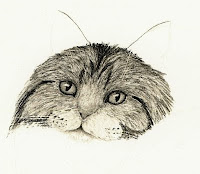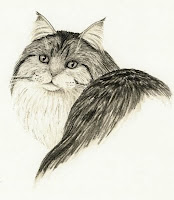This is a long time coming, but I've finally done a demonstration just for this blog on how to draw fur. Long fur, in this case. I hope to do others for different kinds of fur. I am using Strathmore 300 series 70lb drawing paper. It has enough tooth to hold the graphite and charcoal, but not too much to be difficult to add detail. The subject is a Maine coon cat, noted for their size and long, flowing fur.

1- In the first step I have already drawn in the facial features. You can't see it, but I have also indented the paper with a stylus where the whiskers will go. My layout sketch is so light it doesn't show up, either.

2- I use a sharp 6B charcoal pencil for the fur, varying the pressure with the shade. I begin around the eyes. This is very short fur, so my strokes are also very short. I work the bridge of the nose with small, circular strokes with a very light touch. I blend with the same motion using a small blending stump. The left side is the blended charcoal, the right side is unblended. Note in particular that the characteristic M marking on the forehead is not made up of strokes following the M shape, but rather following the fur making up the pattern.

3- I continue to add fur with the 6B charcoal pencil and blending stump. The length of the strokes must match the length of the fur (proportionately, of course). As the fur goes away from the eyes, it gets longer. I fashioned my trusty kneaded eraser into a wedge and dragged it along the fur direction to add highlights, keeping the same stroke length. Finally, I went back over the area lightly with the 4B charcoal pencil to add random marks (random, but again along the fur direction) to add a little more texture to the fur. I also used the kneaded eraser to dab at the bridge of the nose to lighten it.

4- More of the same. Notice how the fur is getting longer as it goes away from the eyes and down the cheeks. For the white fur around the mouth and chin, I applied the charcoal directly with a blending stump. The best way I've found to do this is to grind up some charcoal using sandpaper, then dip the stump in and tap it to get rid of any excess. Use the kneaded eraser to pick up any stray specks.

5- I used the kneaded eraser (dragging in wedge form) to lighten the areas just below the eyes and to erase the smudges that got onto the whiskers (make a real fine point or wedge and it will fit right into the indentation). I also started the ears with the 4B charcoal pencil - small circles at the tips and leading edge, light long lines to create the negative space for the white ear fur.

6- Here I added more fur between the ears and at the back of the head to fill out the head shape. I also lightened the rest of the cheeks with the kneaded eraser. For the ears, I used the blending stump to smooth out the charcoal. Drag the stump from the outside in to create the ear fur and use the kneaded to touch it up.

7- The chest fur is all white, which is once again best applied with a dirtied stump. The Maine coon cat has long chest fur, so use long strokes.

8- Here I've finished the chest fur by adding more charcoal to the right side to create shadow.

9- Switching tactics a little, I used the 6B charcoal pencil to add the shadows of the fur on the back. The fur on the top is fore-shortened, so it looks shorter and we can see the fluffiness better - this means the shadows are closer together. Use strokes that flow down the back.

10- In between the dark shadows, I used the same pencil with a lighter touch to add the rest of the fur. It's okay to leave white patches here and there, so long as they aren't too big. I went for my medium-sized stump to blend it all. The size isn't so much the trick as the condition it's in: it's worn down, almost frayed, so that it has a real soft touch. You could also get this effect with a chamois or felt or other soft blender, but the stump has the added benefit of being small and easy to manipulate.

11- More highlights with the kneaded eraser. To the back fur, once again make a wedge and drag it along the fur to lighten an area. I thought the cat would stand out better with a darker background, so I applied charcoal dust with a chamois. I then used - you guessed it - the kneaded eraser to drag the white fur (chest and ears) into the dark background. (Don't mind the spots on the left, they are
fingerprints and I'm working on photoshopping them out.)
I hope this has been a useful tutorial. I would love to hear from you as to how easy this was to understand, where I could improve, and any other comments. Ultimately, I would like to put together a bunch of tutorials like this into a book.

 Drawing this sea fan was simple, but required a steady hand. I used a base layer of peacock blue and a top layer of dark green for the skeletal structure, fading into aquamarine and olive in the lighter area. I used light aqua for the polyps and light cerulean blue for the hint of water you can see behind it.
Drawing this sea fan was simple, but required a steady hand. I used a base layer of peacock blue and a top layer of dark green for the skeletal structure, fading into aquamarine and olive in the lighter area. I used light aqua for the polyps and light cerulean blue for the hint of water you can see behind it.











